|
Freikorps Danmark
On April 1940, the Germans invaded Denmark with virtually no resistance
encountered by the defending Danes. With the events taking place
during Operation Barabarosa, the Germans started a recruitment
of Danish and Norwegian volunteers for the "Nordland Regiment." 
Danish Volunteer Insignia
On 15 September 1941 the Freikorps Danmark was
sent from Hamburg to the Posen-Treskau training camp. The training
of the Freikorps was not proceeding in order and Leg. Obersturmfuhrer
Kryssing was relieved of command on 8 February 1942. By April
1942, the command of the Freikorps was taken over by Count Christian
Frederick von Schalburg, who served in the SS Panzer-Grenadier
Division Wiking. Von Schalburg was promoted to Sturmbannfuhrer.
At this time "Freikorps Danmark" had 34 commissioned officers,
75 non-commissioned officers, 109 officers and 781 privates. 
Feikorps Danmark Feldpost cover Interesting cover with an Iron Cross label applied instead of the normal feldpost cancel. The sender was SS Leg. Schutze Johannes P. Nielsen, FPN 46050D Reserve Staff/Freikorp Danmark. Notice the file puncture hole on the cover. This cover was also censor with a sealing tape and red SS handstamp.
The Freikorps was sent to Denmark for refitting and placed under the command
of SS-Ostubaf. Knud Borge Martinsen. In October 1942, the Freikorps
returned to the front near the town of Mitau for refitting. On
24 November, the Freikorps left Mitau by convoy and arrived in
the town of Bobruisk, where temporary quarters were set up. A
Danish reserve legion remained in Bobruisk, while the rest of
the Freikorps with a combat strength of 1000 men left to the Front
Lines located near the town of Nevel. 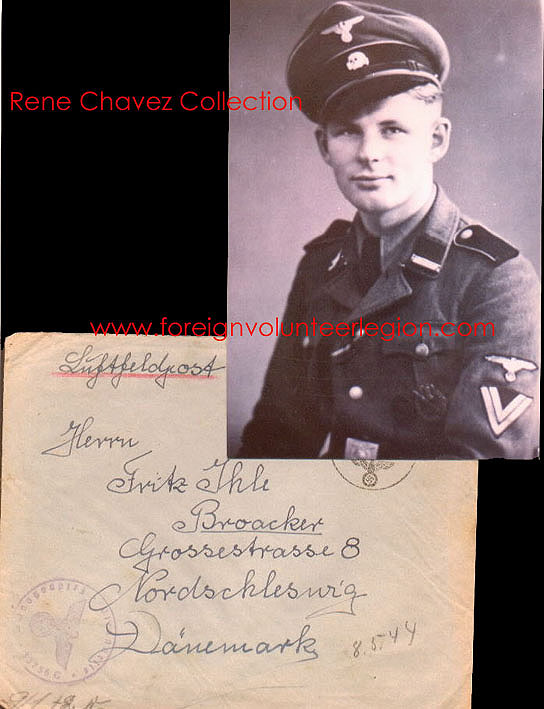
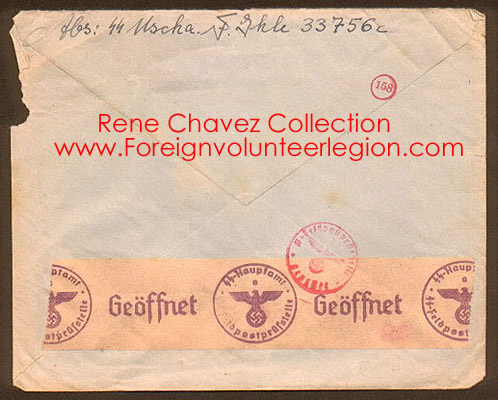
Danish Volunteer Feldpost cover Wonderful rare feldpost from a Danish volunteer in the 11 SS Freiwilligen Panzer-Gren. Division. The sender was none other than SS-Unterscharführer Fritz Ihle who was a "Nordschleswiger" who was assigned to the Armoured Recce Det. 11, and was awarded the EKI. | |
|
Danish Postal History Postal History: On 22 May 1941, the Danish postal administration authorized Feldpost mail to be received in-country free of charge from German and Danish volunteers for mail weighing up to 250gms. A 20Rpf fee was applied in Germany for packages weighing from 250 to 1000gms for German recipients living in Denmark. An additional 25Ore postage was applied to Danish recipients receiving Feldpost packages. Danish volunteers had the same free airmail service as their German compatriots. Domestic postal rates were charged to Danish citizens sending mail to German soldiers. The Danish postal authorities charge 15Ore postal fee for postcards and a 20Ore postal fee for letters weighing up to 250gms. In 1942, the postal rates changed to 20Ore for letters weighing up to 50 gms, and 30Ore for letters and packages weighing from 50gms to 1000gms. All mail was examined and censored by German personnel. | |
|
Feldpost numbers assigned to the Freikorps Danmark In late 1941, the following Feldpost numbers were assigned to the Freikorps Danmark: | |
| Battalion Staff | 46050A |
| 1st. Rifle Co. | 46050B |
| 2nd. Rifle Co. | 46050C |
| 3rd. Rifle Co. | 46050D |
| 4TH. Heavy Mortar Co. | 46050E |
| Training Staff | 45665 |
| Reserve Co. | 48499 |
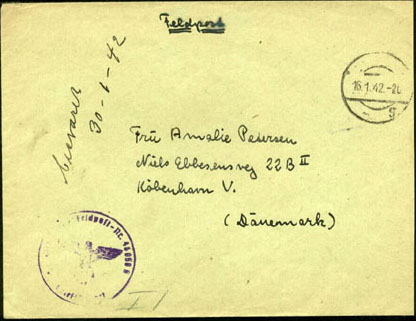
Danish Legion Feldpost Freikorps Danmark Feldpost SS-Feldpost cover mailed by a Danish Legionnaire FPN 46050A Battalion Staff/Freikorps Danmark. Cover was mailed by Leg. Sturmann Flyge to Compenhagen, Denmark. Cover shows Stumme (mute) cancel dated Jan. 16, 1942, volunteer was in training at Posen-Treskau. The mute cancel was used to hide the whereabouts of the legionnaires. The back cover shows a German military sealing tape, which was applied to all covers that were open by the German censors as well as red SS censorship handstamp. | |
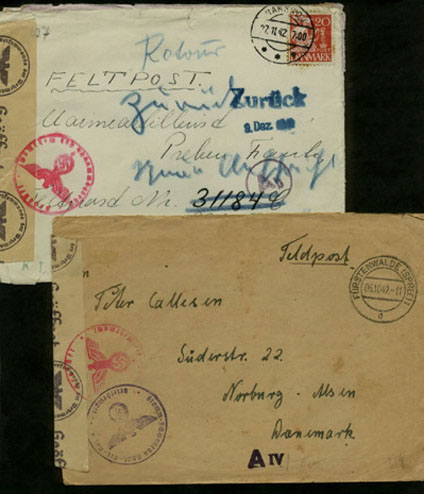
Danish Volunteer Feldpost Danish Volunteer Feldpost Not all Danish volunteers joined the Freikorps. The cover was mailed by a Danish volunteer who was in the German Marine Artillery Rgt 262, 3rd Battery as indicated by the FPN 31184C. Postage was not required since it was mailed through the German Feldpost system. The cover shows blue handwriting and handstamp "ZURÜCK" Return to sender. Notice the word feltpost written in Danish. This cover was also censored as shown. Also shown is another feldpost cover mailed by a Danish in a German reserve motorcycle unit. | |
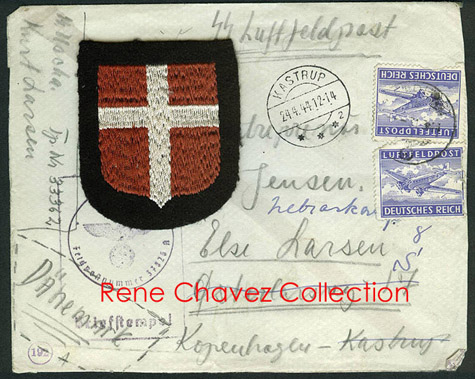
SS-Luftfeldpost cover mailed by SS-Uschaf. Kurt Larsen, FPN 33362, SS Pz-Gren Rgt. Danmark of the Nordland Division. Two military luftfeldpost airmail labels were applied. This cover was mailed via FPN 37826A, II Btl., 5th Co/24th Pz-Gren. Rgt. as shown in the unit seal and upon arrival it was re-applied with the Danish town cancel dated April 24, 1944. The back of the cover shows SS-Sealing tape and SS censor red handstamp. During April 1944, the div. was heavily engaged defending Narva in northeast Estonia. [ Front Page ] [ Top] [Previous Page [Next Page] |
|